A Small Look At Conspiracy Theorists
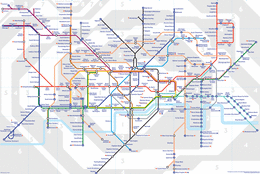
I've decided to come back to my blog at least for a while. I stopped mainly because I had nothing to write about and finding the time to write about nothing isn't exactly number one on my list of priorities. A lot has happened to me in the last 6 months but none of it really important , so i would take this time to look at the things that I've been interested in recently. I've always had a fascination with conspiracy theorists some are obviously more credible than others. The latest one to be doing the rounds is the so called imagery linked to a possible attack on the London Olympics. Theories that include a group called the Illuminati seem to be responsible for everything bad that is happening in the world at the moment. The theorists summarize that they have certain symbols such as the all seeing eye found on the back of the US one dollar bill, numbers such as 9, 11, 13 and 33. So these people spend their time looking for these symbols in popular culture to see if they can for want of a better phrase 'predict the future'.
Even if your not convinced by what they say, you have to give them one thing they are supremely well researched and they are designed to make you think. For example in the video posted they talk about previous terrorist attacks being mentioned in the media in various sources, these attacks include 9/11 which is a conspiracy theorists wet dream.
Even I am not convinced we have heard all the facts about that. Infact I will go so far to say some of their documentaries I have watched make more sense than the official explanations, but this isn't a story about 9/11 and whether or not you believe in that. The 'proof' for these attacks forthcoming on London range from television programs that themselves plan attacks on London several of which seem to point to Big Ben as a target, which is either a large coincidence, lack of imagination from the writers or the conspiracy theorists are correct. Again I will say watch the video for more information on that.
They are also convincing on the all seeing eye symbolism contained within these television programs, and I start to believe these people have 'A LOT' of time on their hands. They even go so far as to say the mascots for the London Olympics containing just one eye is also a symbol, the logo itself is a message as if you move it around it says Zion. In February 2011 the Iranian government issued a formal complaint, saying that Britain's Olympic logo spelled the word "Zion". They initially threatened to boycott the event if the "offensive" logo was not replaced. So there is obviously some truth in this even the mayor of London has said on record 'our Zionist logo'.
These truths are to me slightly peppered with things in the video that I can't see as being true, such as the reference to Private-Eye. Anyone who reads Private-Eye will know their covers have nothing at all to do with what is contained within the magazine 99% of the time, they see a picture (which in this case is from the London riots) and they make a funny caption for it. on their website they have ALL their covers from 30 years and you can see this is nothing out of the ordinary for them. So where does it leave me? Well I have to admit I did watch the panorama program about the terrorist attacks on London and I did find it a bit more than coincidental when the attacks of 7/7 took place same sort of scenario and if your willing to look into it further the bus that exploded wasn't even on the route it was supposed to be on.
But having lived in the UK through the IRA years and seen the devastation that they could produce my fear factor isn't raised by the possibility of such attacks from whatever organization, secret government or any of the worlds known outfits, more people get killed from accidents in the home per month than have ever been killed in terrorist attacks. Having said that it is a fact that governments are the largest unnatural killers of other humans, take communist China they have killed a conservative estimate of around 80 million people. Pol Pot killed 2.2 million Cambodians, and so on and so on until you can make a conservative figure of around 260 million people, And that's just in the 20th / 21st century alone.
So don't think your government is incapable of killing you, some just do it more quietly than others. The Olympics I hope will pass without incident, but It wouldn't surprise me if they didn't. and expect a large we told you so from the conspiracy theorists if they do and a finger pointing exercise by the government, probably involving the words Iran and nuclear. Still don't be fearful this sort of thing happens all the time and is unreported, its just good to keep yourself informed from every side of the square and not just one side and that is what this story is about. Get your news from multiple sources and make your own decisions.....
Below is the Video I was talking about :)
Workers Of The World Unite.......well kind of
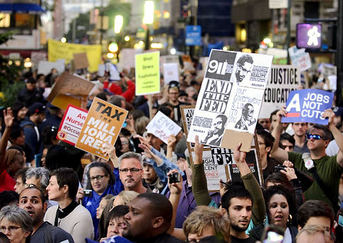 One of the most famous quotes of communism, but I doubt there are many people in the movement that would align themselves to such drastic leanings. To be honest I expect only a fair few would say that there protest for fairer wages, less management oversight and more tax for the rich was in the slightest socialism. Well it is, and that's a good thing. A selection of charts I saw yesterday proved the point that everyone already knows the rich are getting richer and the poor are getting poorer. People have now reached the limit of corporate greed, they have reached the limits of their own lines drawn in the minds of many who call themselves the 99%. Although I agree that they are the 99% who are not that 1% who control 1/3rd of the wealth of the country, they certainly don't have the support of 99% of the population. one of the statements could almost have been made by Lenin or a line from the communist manifesto:
'if you agree that a person is entitled to the sweat of their brows, that being talented at management should not entitle others to act like overseers and overlords, that all workers should have the right to engage in decisions, democratically, then you might be one of us'.
This is unlikely to win cross party support not that I care what would, but are we seeing the beginnings of a new form of political party persuasion. Traditionally workers parties are left wing everything from moderate liberalism to communist depending on how severe your demands are. Something here tells me that people want a new way without embracing any of the socialist leanings.
What I would like to know is what next. A collection of people without a leader which is certainly a protest. There are plenty of people with demands. I read a list of demands and you can almost see the right wing parties exploding if any of these were put into practice
- Single Payer Health Care
- Reinstate Glass Steagall
- Overturn Citizen United/Campaign Finance Reform
- Revoke Corporate Person-hood law
- Close corporate tax loopholes
- Raise taxes on upper incomes
- Address US job outsourcing
Personally I would love to see at least 3 of these addressed but a huge political change would have to happen.
'The problem in a nutshell is this: Inequality in this country has hit a level that has been seen only once in the nation's history, and unemployment has reached a level that has been seen only once since the Great Depression. And, at the same time, corporate profits are at a record high. In other words, in the never-ending tug-of-war between "labor" and "capital," there has rarely—if ever—been a time when "capital" was so clearly winning.'
*for the charts I saw visit
http://www.businessinsider.com/what-wall-street-protesters-are-so-angry-about-2011-10?op=1
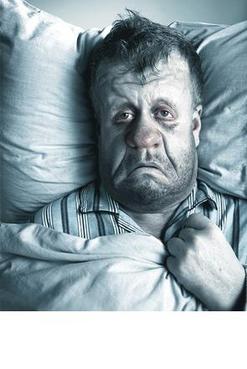 Well the last week and a half has been one of sickness for me with back pain problems and then the flu I haven't had the energy or the will power to write anything at all on the computer.
Anyone else think though that the biggest design flaw in the human body is when we are sick the body's defence is to block off your nose, close your throat and open your bowels. So now you can't eat you can't breathe and even if you do cough you risk a serious trouser accident.
I managed to get my temp up to 103f one night and I must admit I was slightly on the delusional side. Trying to do basic maths is a no go really, so figuring out how much Paracetamol or Acetaminophen I have ingested into my system without going over 6000mg was hard going.
My 'Cup' that I use is about twice the size of a normal mug which is good for tea and coffee as it means I don't have to keep putting the kettle on every 5 minutes to make another brew, but it does mean that one Theraflu™ doesn't cut it, so I have to use two and even then it tastes a bit weak... This combined elixir contains 1350mg of the 6000.
As part of my back pain im requested (and required) to take (at least) one 800mg of Ibuprofen every day. No where could I find if mixing it with the other stuff was a good or bad idea... To hell with it i thought it's only going to be around 2000mg even if it isn't supposed to be mixed...
At some point after that I nodded off, not passed out, or fainted, or died; just fell asleep. When I woke up I had amnesia I didn't know where I was my head was beating so hard it felt like it was going to explode I've never had migraine but I can only assume this is what it felt like I could only just open my eyes to the light, slowly I made my way into the kitchen and into the medicine cabinet I went for the Ibuprofen at first but then spotted the Nyquil that my Wife had brought about a month ago for her cold.
Thinking well its supposed to be for flu I drank straight from the bottle no measure just one big gulp. I made my way back from the kitchen and flopped down on the computer chair. After what felt like 2 hours or so of just staring into black space wide awake with my hands over my face, sweat pouring out of me and a weird sound that I only hear when i'm really sick that I can only describe as your blood flowing, not your heartbeat but the actual flow it's too irregular for a heartbeat, a thought dawned on me. What's actually in that Nyquil. I looked at the bottle contains 625mg of Acetaminophen per 15mg. I drank from the bottle how much is 15mg. to satisfy my delusional mind I poured it out into the measuring cup..I worked out i'd probably had about 8 of them at least in my 'Swig' of the bottle. This is where it started to get complicated I'd taken 1350 with 800 of something else that I wasn't sure would affect it, and now 8 times 625. For the life of me I couldn't work out how much it was, I do know what the answer is now, but at the time it was a mystery I sat at the computer opened up the calculator and punched in the numbers and multiplied them ALL by 8 can't be right, some weird infinite figure flashed up on the screen.
Around this time I fell asleep again. I had a weird dream brought on by raging fever and a delusional mind. I forgot how to sleep and every time I went to sleep my legs would start running in the bed, this isn't part of the dream this is what was happening. I remember being in bed whilst my right leg with no warning lifted itself around head height and slammed itself into the bed with the force of a pro-wrestler, this was really frightening me now.
I decided to have a shower maybe it would help me cool down a bit and settle my nerves, if not I would phone the emergency number and get to hospital. Thankfully the shower seemed to work quite well I felt a little more 'With it' and I came downstairs again.
I realised I hadn't ate in the last 48 hours at all and barely drank through no fault of anyone's but my own. I made myself a small bowl of soup and a cup of tea. It took me over 2 hours to eat that bowl of soup. I had to re-heat it 3 times, I just couldn't swallow it my throat wasn't really hurting that bad. It was, well; normally you don't think about eating, you put food in your mouth, you chew and you swallow, basically that's how eating works.
This bowl of soup was like this: OK its in my mouth now what and if you've ever tried to swallow when your using a part of your brain that doesn't deal with swallowing usually it can be a weird experience. It's rather like breathing you do it automatically but the moment you start thinking about it, in and out, in and out, you can't do it any more.
Feeling slightly exhausted and with another bad migraine type headache, really achy body again I reached for the medicine cabinet again, not thinking really I took another swig of the nyquil I spent the rest of the day doing nothing maybe watching a little TV in between going to the toilet and lying down in the dark. This patten continued over much of the next day.
I remember being asleep I remember turning the light on I don't remember coming downstairs and I certainly don't remember putting the kettle on, it seemed like I came too just as the whistle of the kettle was about to blow itself off. I don't know how long it was boiling for or even how long I'd been there stood next to it staring at it. I made a cup of theraflu™ and watched the snooker. I remember the fever starting to break around Sunday night 4 days after it started. I stopped feeling delusional and more just sick and yucky.
Until today i realised that in those nights i exceeded the recommended dose by about 2500mg every day for 4 days, not only that I felt better for it so it goes to show, in some cases overdose works wonders but I don't recommend it......
So now you know roughly how my last week has been I will get back to writing other stuff soon....
Any time you see an email that says "forward this on to '10' (or however many) of your friends", "sign this petition", or "you'll get bad luck" or "you'll get good luck" or "you'll see something funny on your screen after you send it" or whatever --- it almost always has an email tracker program attached that tracks the cookies and emails of those folks you forward to. The host sender is getting a copy each time it gets forwarded and then is able to get lists of 'active' email addresses to use in SPAM emails or sell to other spammers. Even when you get emails that demand you send the email on if you're not ashamed of God/Jesus --- that is email tracking, and they are playing on our conscience. These people don't care how they get your email addresses - just as long as they get them. Also, emails that talk about a missing child or a child with an incurable disease "how would you feel if that was your child" --- email tracking. Ignore them and don't participate!
Almost all emails that ask you to add your name and forward on to others are similar to that mass letter years ago that asked people to send business cards to the little kid in Florida who wanted to break the Guinness Book of Records for the most cards. All it was, and all any of this type of email is, is a way to get names and 'cookie' tracking information for telemarketers and spammers -- to validate active email accounts for their own profitable purposes.You can do your Friends and Family members a GREAT favor by sending this information to them. You will be providing a service to your friends. And you will be rewarded by not getting thousands of spam emails in the future!
Do yourself a favour and STOP adding your name(s) to those types of listing regardless how inviting they might sound! Or make you feel guilty if you don't! It's all about getting email addresses and nothing more.
You may think you are supporting a GREAT cause, but you are NOT!
Instead, you will be getting tons of junk mail later and very possibly a virus attached! Plus, we are helping the spammers get rich! Let's not make it easy for them!
ALSO: Email petitions are NOT acceptable to Congress or any other organization - i.e. social security, etc. To be acceptable, petitions must have a "signed signature" and full address of the person signing the petition, so this is a waste of time and you are just helping the email trackers.
Tips for Handling Telemarketers
(1)The three little words are: 'Hold On, Please...' Saying this, while putting down your phone and walking off (instead of hanging-up immediately) would make each telemarketing call so much more time-consuming that boiler room sales would grind to a halt.Then when you eventually hear the phone company's 'beep-beep-beep' tone, you know it's time to go back and hang up your handset, which has efficiently completed its task. These three little words will help eliminate telephone soliciting..
(2) Do you ever get those annoying phone calls with no one on the other end?This is a telemarketing technique where a machine makes phone calls and records the time of day when a person answers the phone.This technique is used to determine the best time of day for a 'real' sales person to call back and get someone at home. What you can do after answering, if you notice there is no one there, is to immediately start hitting your # button on the phone, 6 or 7 times as quickly as possible. This confuses the machine that dialed the call, and it kicks your number out of their system. Gosh, what a shame not to have your name in their system any longer!!!
(3) Junk Mail Help:When you get 'ads' enclosed with your phone or utility bill, return these 'ads' with your payment. Let the sending companies throw their own junk mail away. When you get those 'pre-approved' letters in the mail for everything from credit cards to 2nd mortgages and similar type junk, do not throw away the return envelope.Most of these come with postage-paid return envelopes, right? It costs them more than the regular 44 cents postage, 'IF' and when they receive them back. It costs them nothing if you throw them away! The postage was around 50 cents before the last increase and it is according to the weight. In that case, why not get rid of some of your other junk mail and put it in these cool little, postage-paid return envelopes.
Send an ad for your local chimney cleaner to American Express. Send a pizza coupon to Citibank. If you didn't get anything else that day, then just send them their blank application back! If you want to remain anonymous, just make sure your name isn't on anything you send them..You can even send the envelope back empty if you want to just to keep them guessing! It still costs them 44 cents.The banks and credit card companies are currently getting a lot of their own junk back in the mail, but folks, we need to OVERWHELM them.
Let's let them know what it's like to get lots of junk mail, and best of all they're paying for it...Twice!Let's help keep our postal service busy since they are saying that e-mail is cutting into their business profits, and that's why they need to increase postage costs again. You get the idea!
If enough people follow these tips, it will work I have been doing this for years, and I get very little junk mail anymore.
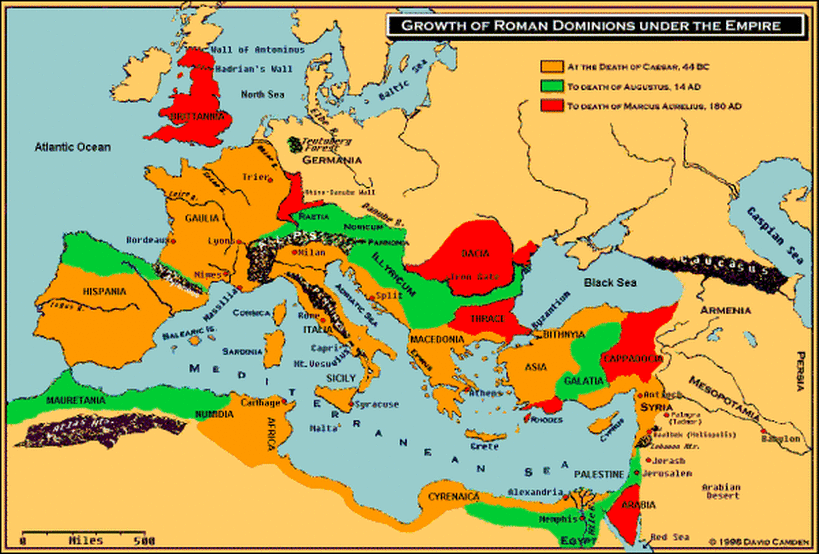 Roman Empire and Its Growth over Europe The Roman empire stretched at its peak a huge distance from it's northern border with Scotland to its southern border in Egypt. From the western edges of Portugal to Syria in the East. Having conquered the Gauls (French) Julius Caesar turned his attention to the North to Brittannia the year was 55BC.
The first expedition, more a reconnaissance than a full invasion, gained a foothold on the coast of Kent (South East England) but, undermined by storm damage to the ships and a lack of cavalry, was unable to advance further. The expedition was a military failure, but was at least a political success. The Roman Senate declared a 20-day public holiday in Rome in honour of the unprecedented achievement of obtaining hostages from Britain and defeating Belgian tribes on returning to the continent. A year later Julius would try again.
In his second invasion, Caesar took with him a substantially larger force and proceeded to coerce or invite many of the native Celtic tribes to pay tribute and give hostages in return for peace. A friendly local king, was installed, and his rival, was brought to terms. Hostages were taken, but the tribute agreed was paid by the Britons after Caesar's return to Gaul with his forces. Britain would wait nearly 90 years before they next saw a Roman army.
Caesar had conquered no territory and had left behind no troops, but had established clients on the island and had brought Britain into Rome's sphere of political influence. This made Britain into a part of the Roman empire without being conquered. Trade with the Romans and friendly cheiftains meant the Romans had little to do with Britain until around 46bc when Claudius received two tribal leaders who had been exiled by their tribes no longer friendly chiefs meant reduced trade and higher prices this could only mean one thing a full scale invasion of the commercially viable southern English people.
The army when assembled then proceeded to mutiny against their leaders because they were scared of crossing the channel. Eventually they were persuaded to get on the boats and in 43ad they set off. They probably landed around Fishbourne in Kent, one of the shortest channel crossings. No record has been made about how many Legions (Legions consisted of around 6000 men) were sent to Britain we know for sure that there were 4 legions in 60bc when a small revolt was squashed so we can assume that they had been there since the invasion.
Roman armies were obviously better equipped and better led with far superior military tactics. This isn't to say that it was a walk over as I stated before some tribes actually quite liked the Romans so in some areas resistance was minimal. A battle was fought in Kent and the Romans pushed up towards the river Thames and London. The Emperor Claudius was then summoned with reinforcements which included Elephants, we can only guess what the Britains thought of these animals as we can be pretty sure they had never seen them before.
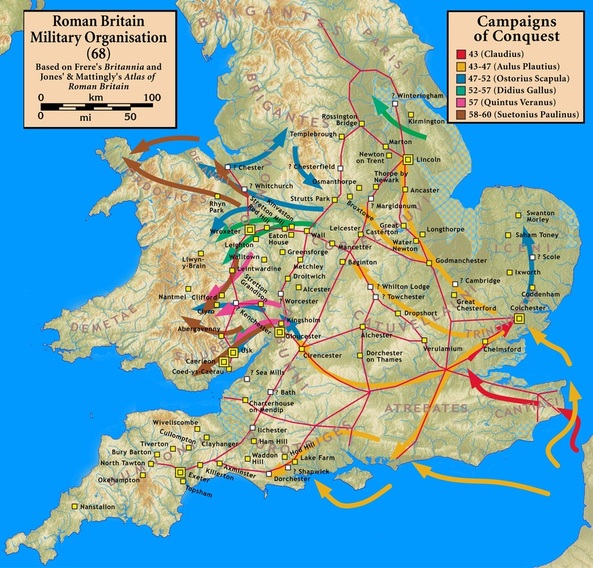 By 60AD most of Southern England was under Roman control, this isn't to say that everything was now peaceful. Romans trying to push into Wales were meeting with severe resistance to their occupation. Northern England too both due to their Hill and moor terrain meant that ambushes and guerilla style tactics could come into play. Remembering of course that most of Britain at the time was forested too. Some people in southern England were quick though to adapt to Roman ways and new styles of buildings and the luxury living that the Romans brought with them were starting to appear as early as 60ad. Although 60ad was a bad year to be a Roman in Southern Britain. In what is now East Anglia in the far east of Britain lived a tribe called the Iceni. The Iceni were led by a king called Prasutagus who died he left in his will half his lands to the Roman Emperor Nero in the hope that the other half would remain untouched. His widow was called Boudica. The Romans decided to take all of the Iceni lands and raped two of Boudica's daughters in the process and whipped a lot of the rest of the tribe into submission. In response, the Iceni, joined by the Trinovantes, destroyed the Roman colony at Colchester (which was then the capital city of the new Roman province) and routed the part of the IXth legion that was sent to relieve it. Boudica then went on to also burn to the ground the cities of St Albans and London. The scorch marks of the fierce burning can still be seen in the ground today as a bright red layer filled with charcoal. Between seventy and eighty thousand people are said to have been killed in the three cities. But the Romans regrouped with two of the three legions still available, chose a battlefield, and, despite being heavily outnumbered, defeated the rebels. Boudica died not long afterwards, by self-administered poison or by illness. There was further turmoil in 69ad. Rome was at civil war in a year which saw 4 emperors come and go usually by murderous means. Unable to control the legions in Britain several commanders took their chance including one Venutius of the Brigantes who quickly took control of most of northern Britain. Eventually he too was defeated by the Emperor Vespasian. In the following years, the Romans conquered more of the island, increasing the size of Roman Britain. Contrary to popular belief the Romans did enter Scotland they even defeated the Caledonians in battle but a influential commander called Agricola was recalled and the Romans pulled back to the more defensible position today occupied by Hadrian's wall.
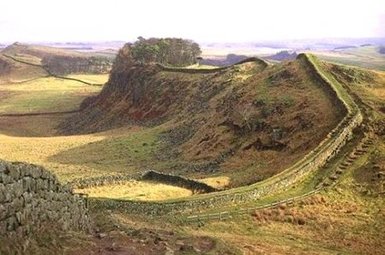 Hadrian's Wall Built around 120ad Hadrian's Wall was 80 Roman miles (73 statute miles or 120 km) long. its width and height dependent on the construction materials which were available nearby. East of River Irthing the wall was made from squared stone and measured 3 metres (9.7 ft) wide and five to six metres (16–20 ft) high, while west of the river the wall was made from turf and measured 6 metres (20 ft) wide and 3.5 metres (11.5 ft) high. This does not include the wall's ditches and forts. The central section measured eight Roman feet wide (7.8 ft or 2.4 m) on a 10-foot (3.0 m) base. Some parts of this section of the wall survive to a height of 10 feet (3.0 m). It wasn't built to keep the Scottish In or the English out it was to stop raiding parties from coming south and it also forced the Scottish traders to pay taxes. Life on the wall was fairly peaceful if not a remote posting for the soldiers posted there. One of the forts on the wall was called Vindolanda. When they were digging they found some of the most personal Roman remains ever found wax tablets with writting on them allow us to know what life was like on the frontier in Roman times. Things like invitations to birthday parties and feast days are common as well as asking for supplies usually heavy clothing to cope with the cold and bitter weather. But one thing they allow us to do is show where the Roman soliders came from. They were coming from all over the Roman Empire from northern Africa, Spain even Turkey. Most of the large forts were fitted with the modern luxuries such as plumbing, bath houses, running water,
A further wall was built north of Hadrian's wall called the Antonine wall. The occupation of Scotland ended as a result of a further crisis in 155-157 AD, when the Brigantes revolted. With limited options to despatch reinforcements, the Romans moved their troops south, and this rising was suppressed Within a year the Antonine Wall was recaptured, but by 163 or 164 AD it was abandoned. Since the retreat to the Hadrianic frontier occurred not long after his death when a more objective strategic assessment of the benefits of the Antonine Wall could be made. However the Romans did not entirely withdraw from Scotland.
after the first century AD the Celts who lived in what is now England were, to a certain extent, Romanised. Many towns appeared. Some were created deliberately. Others grew up by Roman forts as the garrisons provided markets for townspeople's goods. Roman towns were usually laid out in a grid pattern. Streets were often covered in gravel. When people walked on the gravel it became compacted. Very often streets had drains at the sides.
At first Roman towns were unprotected. Then in the late 1st and 2nd centuries fortifications were built. They consisted, at first, of ditches with earth ramparts and wooden palisades. Later many towns had stone walls.
In the centre of Roman towns was a space called the Forum. It was lined by shops and by a public building called the basilica. Markets were also held on the forum. In the towns another important building was the public baths. In Roman times people went to the baths not just to get clean but also to socialise. Roman Baths consisted of a frigidarium or cold room, a Tepidarium or warm room and a caldarium or hot room. You usually finished with a dip in a cold pool.
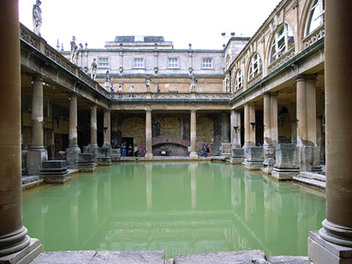 Roman Baths in Bath (Aqua Sulis) To clean themselves Romans rubbed their skin with oil and scraped it off with a tool called a strigil.
Larger towns also had an amphitheatre where 'sports' such as cock fighting were held and sometimes gladiators fought to the death. Some Roman towns also had theatres. The Romans gambled with dice. They also played board games. Roman children played with wooden or clay dolls. They also played ball games.Roman Britain was, of course, an agricultural society where most people made their living from farming (although there were many craftsmen). Only a small minority of the population (probably around 10%) lived in towns. he Romans also introduced new foods into Britain, among them celery, cabbages, radishes, carrots, cucumbers, broad beans and walnuts. Romans cooked on charcoal stoves. Olive oil was imported. So were olives, figs and grapes. Wine was also imported (although the Romans attempted to grow vines in Britain).
The Romans were also very fond of fish sauce. They also liked oysters, which were exported from Britain.
A Roman dining room was called a triclinium. The Romans ate a breakfast of bread and fruit called the ientaculum. At midday they ate a meal called the prandium of fish, cold meat, bread and vegetables. The main meal was called the cena and was eaten in the evening.
Life in Roman Britain was, if you wern't a slave good living. By the year 200ad the era known as the Pax Romana (Roman Peace) had started and the country became more and more romanised.....Like all good things this wasn't to last more of that in Part 5.....
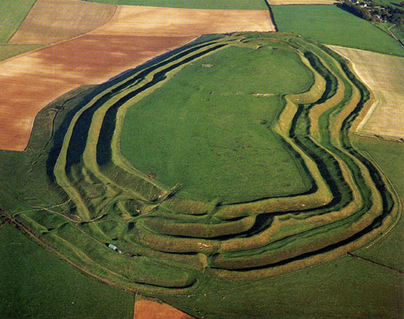 Welcome to Maiden Castle built around 600bc near Dorchester in the UK. Looks impressive on the picture. Even more impressive on the ground. Hill forts developed in the Late Bronze Age and Early Iron Age, roughly the start of the first millennium BC (1000bc). The reason for their emergence in Britain, and their purpose, has been a subject of debate. It has been argued that they could have been defensive sites constructed in response to invasion from continental Europe, built by invaders, or a military reaction to social tensions caused by an increasing population and resulting pressure on agriculture. The dominant view since the 1960s has been that the increasing use of iron led to social changes in Britain. Deposits of iron ore were located in different places to the tin and copper ore necessary to make bronze. As a result, trading patterns shifted, and the old elites lost their economic and social status. Power passed into the hands of a new group of people. The end of the use of Bronze as a currency and the recent climate change shifted the focus from metals to ownership of land and animals as the source of wealth. If you owned land and animals and you could afford to feast your people you were a wealthy person. If you owned Maiden Castle you certainly owned a lot of land, a lot of people, and therefore a lot of wealth. Your fort wasn't just a military installation though it was where you lived, where you feasted and where you died.
Lets imagine your a Celtic Britain of the middle order, middle class if you like, what would your life be like. Well you probably owned a small farm as you can see from the picture there are plenty of plots to choose from. You would have probably kept animals, grown wheat or barley. You would have made your own bread, your own ale, your own clothes (usually woollen made on a weaving loom) or animal skins. You would have butchered your own animals raised and educated your own children, ploughed and harvested your fields gone fishing and collected herbs, nuts and berries. Your house would have been a traditional round house made from wattle and daub (mud and dung thrown onto a woven stick structure that looks like a woven basket and dried). Inside you would have had a central fire place on a clay floor covered with either straw or animal skins. The whole building would be about 20ft in diameter. Outside you would have your pens for the animals, a clay oven and a long way from your door the latrine. So your starting to get modernised now you'd have even had your own bed although you would have to share it in winter with the cattle and sheep.
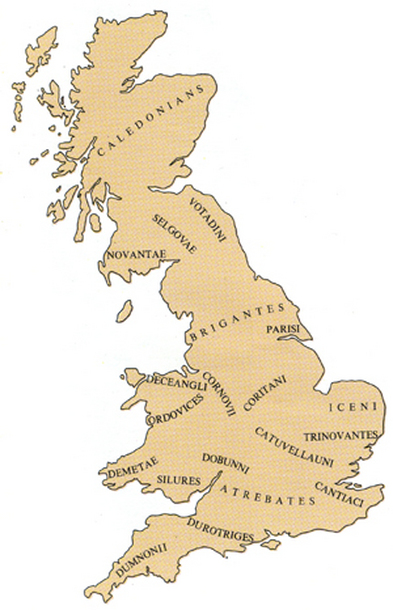 If you lived in what is now Great Britain you would have belonged to one of these tribal areas. People like me from Manchester would have been Brigantes. Londoners would have been Cantiaci on the south side of the river Thames and Catuvellauni on the other side. These names are of course the Latin names for the tribes given by the Romans but they give some idea of the amount and distribution of the tribes. If you lived in Maiden Castle you would have been a Durotrigeses and you would have farmed some of the most fertile land in the country, hence the need for the most protection in the country too. Scotland had a different system of defence they had Brochs a large dry stone structure that looks rather like a Rook (castle in chess) and they were placed like lighthouses on high ground they consisted of a large outer wall and an inner wall with a passageway just wide enough for a man in between the two from where you could find a small window and defend your property. Not much is really known about the Scottish Caledonians as they left no written records and they were never conquered by the Romans, subsequently their iron age lasted almost 500 years longer than the English iron age.
Your Religion as an Iron age Celt would have probably been the worship of many gods and human sacrifice was practised until the Romans banned the practice by 150AD so chances are you knew someone or had someone within your family who was offered up to appease the gods. This was a huge honour for the family and sacrifices were not chosen lightly they didn't just offer any old soul to the gods, after all they were trying to make them happy not infuriate them. You would have had a chief druid or shaman who's job it was to interpret the will of the gods and also to provide medication for the tribe.
Some Images of Iron age (Celtic) Britain
continues below
Trade with Europe was rife during the Iron age and the Celts enjoyed such luxuries as wine from Italy and olives from Spain. Iron weapons were imported at first before local knowledge was brought into the country. Fancy decorative items were being produced as well as wealthy items made from gold. The Celts also used the 1st coinage found in the country although we are unsure what sort of value these coins had and what you could buy with them, its thought that they must have been trading with Roman Europe and borrowed the idea from them. The Iron age lasted a relatively short period of time in Britain. Iron objects never held as much value to the tribes as bronze did. But they made highly useful tools with iron. Food production increased dramatically with the introduction of the iron tipped plough and every day objects we now take for granted were starting to be made. Knifes and forks, all types of wood working tools that have changed little to the modern day and lots of cooking implements pots and pans. But life was to take a dramatic turn for the tribes of Great Britain when they first saw the boats of Julius Caesar sailing slowly across the channel in 55bc....Veni Vivi Vici....... well almost...more of that in Part 4
 WALLINGFORD - Alice M. Bruton Mann, 89, formerly of Loring Court, Yalesville, died Saturday, April 9, 2011 at the Regency House. She was the loving wife of the late Frank Mann.
She was born in Wallingford, May 8, 1921, a daughter of the late Leo and Myrtle Stone Bruton. Mrs. Mann owned the Salad Bowl Deli/Restaurant on Quinnipiac Street until she retired. She was well known for her beaded shirts, her love of bingo, and her love of Vermont. She was a loving mother and will be missed by all who loved her.
She is survived by her daughter, Gloria Doucette, of Wallingford; her three granddaughters, Deborah Bailey of Wallingford, Jennifer Winnard, of Meriden, and Alicia Carafano, of West Haven; her six great-grandchildren; her special friend and daughter-in-law, Berit Mann, of West Haven; her sister-in-law, Carolyn Bruton, of Wallingford; and several nieces and nephews. She was predeceased by her son, Francis John Mann; and her granddaughter, Johanne Whirley Doucette.
Her family will receive relatives and friends in The Wallingford Funeral Home, 809 North Main St. Ext., Wallingford, Monday, April 11, from 4 to 6:45 p.m. Funeral services will be held Monday, at 7 p.m. in The Wallingford Funeral Home. The Rev. Anne Bracket, Pastor of the Yalesville United Methodist Church will officiate. Interment will be private.
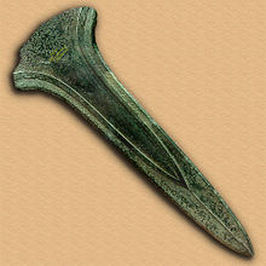 The Bronze age started around 3000bc, nobody is really sure how it happened or who invented the method. Bronze is an alloy of two metals Copper and Tin. So who ever thought of this was a pretty clever person. The melting of Copper was probably found out when someone threw copper laden rocks onto a fire. If you know a little chemistry you will know that this will turn the flames of the fire green. In an age of mystics and believed magic this would have been an impressive sight rather like a firework today. The addition of Tin however remains a mystery. What we do know about tin is it's not widely available, in actual fact its quite a rare metal. One of the sources of this metal was Cornwall in the south west corner of the United Kingdom. Trade of this metal was rife with other sources on the other side of the English Channel in France. The earliest bronze objects had tin or arsenic content of less than 2% and are therefore believed to be the result of unintentional alloying due to trace metal content in the copper ore. Tin was first mined in Europe around 2500 BC knowledge of tin bronze and tin extraction techniques spread to Brittany and Cornwall around 2000 BC and from north-western Europe to north-western Spain and Portugal around the same time.
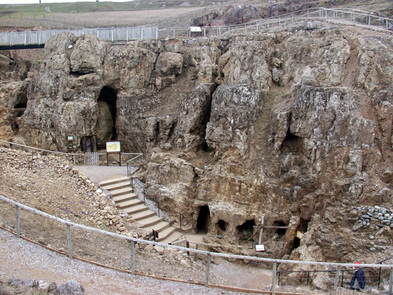 This is Great Orme copper mine in Llandudno, Wales. This is the Oldest mining structure in the world. Each of those hole you can see has been mined by human hand using stone tools (Bronze tools would have been far to valuable and fragile to use on such a surface) and deer or reindeer antlers shaped into picks. Some of the holes are so tiny they can only have been worked by children some maybe as young as five years old. The workings go deep into the rock surface where they would have worked in pitch darkness in cramped spaces with high levels of humidity, many phobias in one place for many. The ore would have been processed by women and men to old to mine, pounded with large rocks to extract the valuable copper. This metal would then have been smelted to form copper ingots around the size of a golf ball. Trade from Llandudno would have been fairly easy on the coast where tin could have been imported and copper exported.
In Great Britain, the Bronze Age is considered to have been the period from around 2100 to 750 BC. Migration brought new people to the islands from the continent. Recent tooth enamel isotope research on bodies found in early Bronze Age graves around Stonehenge indicate that at least some of the migrants came from the area of modern Switzerland. The Beaker culture displayed different behaviours from the earlier Neolithic people, and cultural change was significant. Integration is thought to have been peaceful, as many of the early henge sites were seemingly adopted by the newcomers. What is the Beaker culture well they were people who used a specific type of pot found all over western Europe. Simply its a cup that looks a lot like a modern day beaker or cups without the handles.
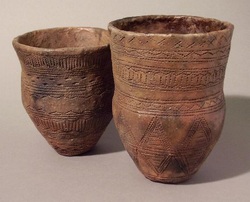 A pair of Bronze age beakers These Beakers were used for everything from drinking to storing the cremated remains of ancestors and they come out of the earth everywhere. Archaeologists believe that they are modelled on the crucibles that metal workers would have smelted the metal in so to many people they were a source of magic and held many properties of the gods.
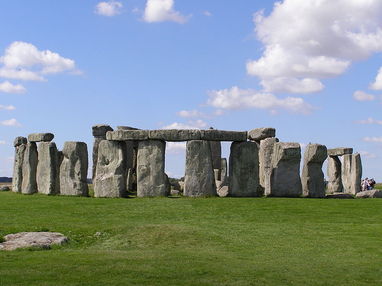 Around this time a man known as the Amesbury archer was buried he is a classic beaker person and during this time when burial was getting more individual this man was given a full ceremonial burial. His grave had the greatest number of artefacts ever found in a British Bronze Age burial. Among those discovered were: Five funerary pots of the type associated with the "Beaker culture"; three tiny copper knives, more for show than for violent use; 16 barbed flint arrowheads; a kit of flint-knapping and metalworking tools, including cushion stones that functioned as a kind of portable anvil and that suggests he was a smithy; and some boar's tusks. On his forearm was a black Stone wrist-guard. A similar red wrist-guard was by his knees. With the second wrist-guard was a shale belt ring and a pair of gold hair ornaments. It has been suggested that he was a part of Stonehenge's construction or a very important member of the society there. Opposite is a picture of Stonehenge in Wiltshire. It was probably built first around 4000bc but the Stonehenge you see today in the picture was built around 2600bc The big stones you see on the outside are local stones to the area and came from the Marlborough downs about 15-20 miles away still some task to drag there. they were hauled upright by brute force. you build a dirt slope and you use a wooden A frame so called because it looks like an 'A' you put rope over the top of the A and haul. The top stones were a little different they used wood to hoist them up. Place one hand on the other at 90 degree angles, then remove the hand and place it on top. This is how they raised the stone. You lift it at one side, slide wood under it lift it on the other side slide wood under it and so on until its level with the top of the standing stones then you shuffle it over with big tree trunk sized levers and it fits into two stone sockets on top of the stones. The really amazing bit is the stones INSIDE Stonehenge. These smaller stones are blue-stones they have a glittery blue shine to them. They come from a place in Wales over 200 miles away. which means they had sophisticated trading methods and also good transport networks. The stones were probably shipped by boat rather than dragged overland as Stonehenge is quite close to a major British river, the River Avon. (Curiously Avon means River, so its real name is River river, which is pretty unimaginative, until you realise there are 6 rivers called the River Avon in England)
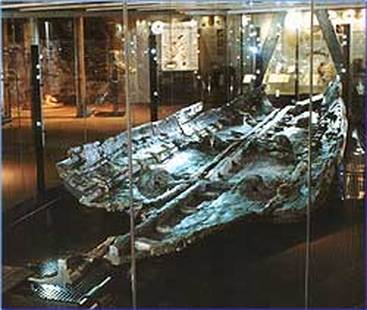 Here is a picture of a Bronze age boat, in fact one of the few bronze age boats ever found in the world. Its structure however would not be unfamiliar to a modern boat builder. The boat was made up of at least six oak timbers lashed together with yew wood, with all the joints reinforced with a thin lath of oak, covering moss pushed into the joint. The two central planks are joined by the use of wedges pushed through a central rail and a series of cleats hammered together. Sails would have been made using hazel weave rather like a basket weave only on a flat surface this would have allowed the boat to travel vast distances all over Europe.
The Bronze Age people lived in round houses and divided up the landscape. Stone rows are to be seen on, for example, Dartmoor. They ate cattle, sheep, pigs and deer as well as shellfish and birds. They carried out salt manufacture. The wetlands were a source of wildfowl and reeds. There was ritual deposition of offerings in the wetlands and in holes in the ground. They were a sophisticated people just think when would you have ever thought of heating rocks up to make metal....
The end of the bronze age was caused by a number of things. Chiefly amongst those was climate change. The weather got colder and wetter. People were no longer using bronze as a currency anymore and much like to day a financial and economical crisis took place. Hordes of bronze age axes were piled into the ground by people who must have been hoping that once the famine and hard times passed they would return to life as they had always known it. This wasn't to be. Along with a horde that was dug up in Isleham near Ely in the English county of Cambridgeshire, there was one mysterious object that wasn't Bronze.....It was Iron.....
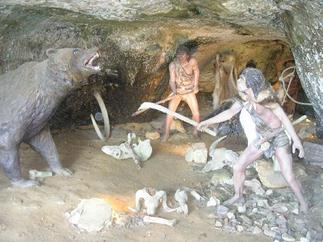 The stone age. It conjures up images of people in caves, wearing bearskins around a fire huddling for warmth and occasionally going out and clubbing a mammoth. Like all things on Earth it's a little more complicated than that. For one the stone age spans nearly 2.5 million years from our very early ancestors to the bronze age where our first usage of metal was incorporated around 6000bc give or take a thousand years. So for most of human history we were as the title suggests banging two rocks together. Nobody really knows who was the 1st person to pick up a stone and realise the potential for not just killing animals but a whole range of tasks, skinning animals, butchery, tree cutting, bowls, grinding nuts and later grains for flour. the most versatile of these stones was flint (obsidian too but mostly flint). It was the original Swiss army knife. hitting flint at the right angles and with the right tools can produce razor sharp objects and we pull these objects out of the ground on a regular basis. We find their chippings, there tools and there mistakes. What we do know is the oldest tools ever found are over 2 million years old and were found in what is now Ethiopia in Africa. Humans tended to live in small nomadic bands following the animals as they moved through the seasons, collecting nuts and berries and hunting as they needed for food. Fishing and seafood collecting started in the middle stone age around 100,000 years ago. At this time there were still Neanderthals roaming our earth. Far from being primitive and backwards. Scientist now think we interbred with this off cut our species and some traits are still visible to this day. They made complex tools they hunted the same way we did what finally led to there demise nobody knows for sure. Neanderthal usage of projectile weapons in hunting occurred very rarely (or perhaps never) and the Neanderthals hunted large game animals mostly by ambushing them and attacking them with mêlée weapons such as thrusting spears rather than attacking them from a distance with projectile weapons. This is probably what drove them to smaller numbers as Homo-Sapiens took more and more game away from them.
From 50,000 to 10,000 years ago in Europe, the Old stone age ends with the end of the old stone age and onset of the Neolithic era (the end of the last ice age). Modern humans spread out further across the Earth during the period known as the Neolithic. The Old Stone age is really marked by a relatively rapid succession of often complex stone artefact technologies and a large increase in the creation of art and personal ornaments.
The Americas were probably colonised via the Bering land bridge which was exposed during this period by lower sea levels. These people are called the Paleo-Indians, and the earliest accepted dates are those of the Clovis culture sites, some 13,500 years ago. Globally, societies were hunter-gatherers but evidence of regional identities begins to appear in the wide variety of stone tool types being developed to suit very different environments.
NEOLITHIC
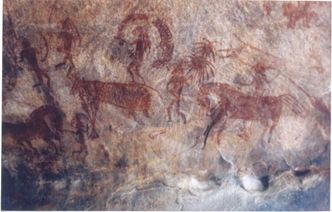 What made the Neolithic different from the stone age was the invention of farming. The planting of crops to take a yearly harvest. Around 9000bc the first humans realised that when they dropped the seeds or berries of the food they were gathering some would grow into new food sources where they were dropped some clever people realised that if they gathered enough of these seeds and dropped them onto the earth they could be gathered (or harvested) in time for the winter. This with the start of Animal Husbandry the ability to keep animals for food was the start of a rapid expansion in the human race and the beginning of the first towns and cities. Grains were ground into flour and the first bread was baked. In the last few years, remains of figs were discovered in a house in Jericho dated to 9400 BC. The figs are of a mutant variety that cannot be pollinated by insects, and therefore the trees can only reproduce from cuttings. This evidence suggests that figs were one of the first cultivated crops and mark the invention of the technology of farming. This occurred centuries before the first cultivation of grains. Settlements became more permanent with circular houses, these houses were for the first time made of mud-brick. Around 8500bc the first signs of ritual burial are found people preserved skulls of the dead, which were plastered with mud to make facial features. The rest of the corpse may have been left outside the settlement to decay until only the bones were left, then the bones were buried inside the settlement underneath the floor or between houses. By 6500bc Pottery was being developed. It seems a trivial invention now but this was the start of storage large pots full of grain meant that you could store some of last years harvest in case the coming years harvest was poor. you could also store flour and carry water. This also allowed for the first trade as you now could pack up your pot full of grain take it to someone and trade it for whatever they had animals,clothing or whatever their needs were (this is Probably where the 'Oldest Profession' really started to take hold).
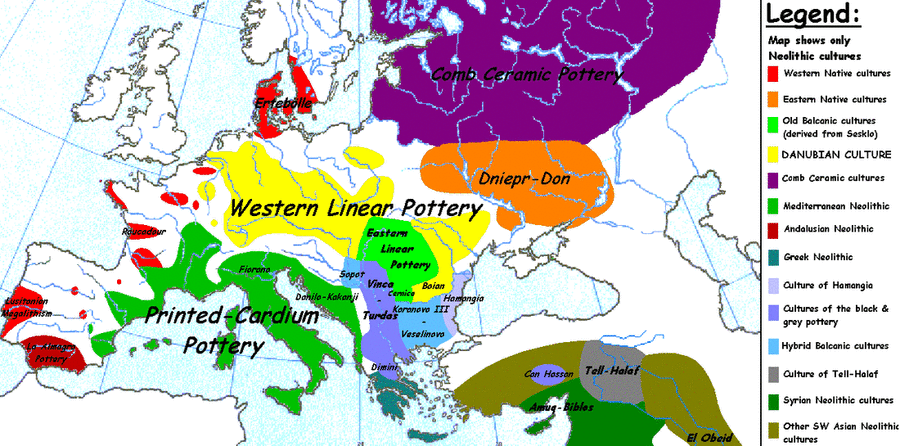 Map showing the various regions of human activity during the Neolithic period
However, early farmers were also adversely affected in times of famine, such as may be caused by drought or pests. In instances where agriculture had become the predominant way of life, the sensitivity to these shortages could be particularly acute, affecting agrarian populations to an extent that otherwise may not have been routinely experienced by prior hunter-gatherer communities. Nevertheless, farming communities generally proved successful, and their growth and the expansion of territory under cultivation continued. Another significant change undergone by many of these newly-agrarian communities was one of diet. Pre-farm diets varied by region, season, available local plant and animal resources and hunting. Post-farm diet was restricted to a limited package of successfully cultivated cereal grains, plants and to a variable extent domesticated animals and animal products. Supplementation of diet by hunting and gathering was to variable degrees precluded by the increase in population
above the carrying capacity of the land and a high sedentary local population concentration. This led to more and more migration to find more land and more farming. Neolithic man was fast becoming the dominant species and by 4000bc had discovered something rather magical..... More on that in Part Two...
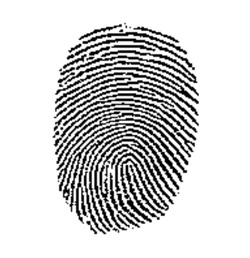 I had to get my fingerprints taken and a new mug shot for my Immigration card today. Funny that there was nobody there today other than myself. Last time I went the place seemed to be packed with people It was like waiting at Ellis Island for processing. We set off really early and got there an hour before my appointment was due expecting it to take some time to get processed and waiting. We were back before the time my appointment was scheduled for. If only every appointment in life was this efficient. After we got back with lots of time to kill before my daughter was out of school we went for a meal in the local diner. We've never been in there before even though it has been there almost 18 months now. It was fantastic great food, friendly staff and of course endless cups of coffee. It was here that I started reflecting on why they are so many Illegal immigrants in this country. Its the price of legal immigration that's the problem. Just to get to where I am in the process now, which is awaiting my 10 year green card. I may have another interview but the whole cost is nearly $6,000 who can afford to pay that from a poor country. I'm lucky to have a lot of support as well as a job that helped pay for the cost. (out of my own pocket no sponsorship for me) I'm just grateful that this pending another interview is the last time I have to do this for the foreseeable future, but I do feel for the 1000's of people who want to be a part of this process who either can't afford it or just want to try and get a better life. I'm torn between a rock and a hard place when it comes to illegal immigration. Part of me is annoyed because I've gone about it the proper way, but part of my can emphasise with them. After all don't we all want what's best for our family and they are just the same.
|




















 RSS Feed
RSS Feed